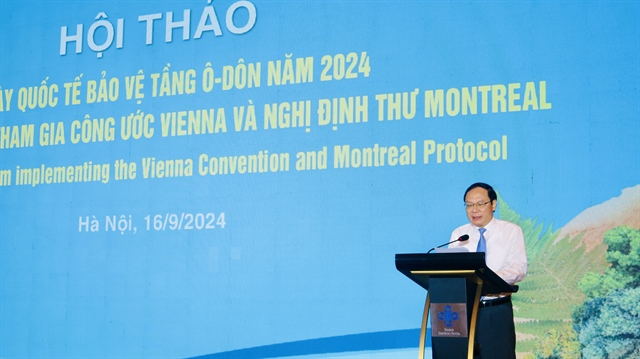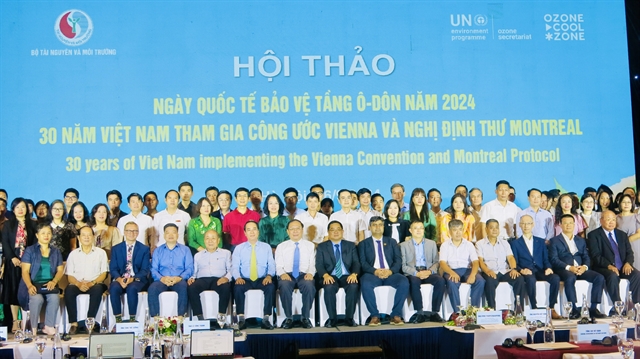 Environment
Environment

 |
| Lê Công Thành, Deputy Minister of the Ministry of Natural Resources and Environment, delivers his speech at the seminar on Monday morning in Hà Nội. — VNS Photo Nguyễn Hằng |
HÀ NỘI — Việt Nam has eliminated approximately 220 million tonnes of CO2 and equivalent greenhouse gases after 30 years of participation in the Vienna Convention and the Montreal Protocol.
This success comes as Việt Nam has also been internationally recognised as an active and highly responsible member of both international agreements, making significant efforts to manage and eliminate ozone-depleting substances and greenhouse gases.
Lê Công Thành, Deputy Minister of the Ministry of Natural Resources and Environment, revealed the country's accomplishments at a seminar titled 'International Day for the Preservation of the Ozone Layer 2024: 30 Years of Việt Nam’s Participation in the Vienna Convention and Montreal Protocol' in Hà Nội on Monday morning.
Shortly after joining the Convention and the Protocol in 1994, Việt Nam launched the National Programme for the Gradual Elimination of Ozone-Depleting Substances in 1995 and established the National Programme Office to coordinate and implement activities to eliminate substances controlled under the Montreal Protocol from 1996.
In the first decade of participation (1994-2004), Việt Nam began to develop and implement regulations to manage and control the use of ozone-depleting substances, while also supporting businesses in transitioning technologies to eliminate these substances.
Between 2004 and 2014, the country intensified its efforts to protect the ozone layer by issuing numerous regulations and directives to manage the import and export of controlled substances, regulate refrigeration equipment using chlorofluorocarbons (CFCs) and limit the establishment or expansion of businesses using hydrochlorofluorocarbons (HCFCs).
Alongside other countries in the region, Việt Nam met its obligations by completely phasing out the consumption of CFCs, Halons and Carbon tetrachloride (CTCs) by 2010, halting HCFC consumption at baseline levels by 2013 and supporting technology transitions for businesses.
Since 2014, Việt Nam has focused on refining its institutional framework and policies.
The legislative and policy system for ozone layer protection and management of ozone-depleting and greenhouse gases is now largely complete, Thành said.
Foam manufacturers, air conditioning and refrigeration equipment producers have ceased using ozone-depleting substances in production, while the import and consumption of controlled substances follows a phased schedule.
“Methyl Bromide is now used only for quarantine and soil fumigation in agriculture,” he added.
In 2019, the Government approved participation in the Kigali Amendment to the Montreal Protocol, which aimed to enhance the management of greenhouse gases (HFCs) used to replace phased-out ozone-depleting substances.
Ozone protection provisions were included in the Law on Environmental Protection.
The Government Decree No. 06/2022/NĐ-CP detailed greenhouse gas emission reductions and ozone layer protection.
Technical guidelines, standards and regulations were also established in the decree.
Challenges
As for the challenges faced in implementing the Montreal Protocol, Tăng Thế Cường, head of the Department of Climate Change under the ministry, said while Việt Nam’s 30-year efforts under the Vienna Convention and Montreal Protocol have been internationally recognised, there are still obstacles.
Việt Nam has established a policy and legal framework for ozone protection and management of controlled substances, but effective implementation requires further technical standards and guidelines.
“There is a shortage of skilled personnel in Government agencies and experts knowledgeable about new technologies and refrigerants,” he said.
Additionally, many Vietnamese businesses face financial constraints in adopting modern technologies.
Cường recommends leveraging domestic resources and international support for finance and technology.
Specific measures should include financial mechanisms to encourage investments in climate-friendly technologies, energy efficiency and reductions in the use of ozone-depleting substances and greenhouse gases.
Future tasks
 |
| Participants at the "International Day for the Preservation of the Ozone Layer 2024 - 30 Years of Việt Nam’s Participation in the Vienna Convention and Montreal Protocol" seminar in Hà Nội on Monday morning.—VNS Photo Nguyễn Hằng |
Thành said in June 2024, the Prime Minister issued the National Plan for the Management and Elimination of Ozone-Depleting Substances and Controlled Greenhouse Gases under Decision No. 496/QĐ-TTg.
The plan aims to reduce carbon emissions by more than 11 million tonnes by 2045, contributing to the goal of achieving net-zero emissions by 2050.
Several key tasks were identified to continue effectively implementing the plan, he said.
First, it needs further refining of institutional and policy frameworks for managing and eliminating controlled substances as well as establishing technical standards and guidelines.
Strengthening inter-agency coordination for legal enforcement, enhancing import-export controls and managing the use of controlled substances is also required, with a focus on the roles of customs, market management and regulatory bodies.
Second, encouraging and supporting the transition to climate-friendly technologies and improving the energy efficiency of cooling equipment is advised.
It is also crucial to promote the collection, recycling and treatment of controlled substances per the Montreal Protocol and implement sustainable cooling technologies and services in urban areas, residential buildings, offices, commercial establishments and public infrastructure.
Third, it must implement training programmes to enhance the skills of enforcement personnel, instructors at training institutions and those involved in certification.
Continuing international cooperation and mobilising global support to meet national objectives are imperative, he said.
International assessments
Speaking at the event, Megumi Seki, Executive Secretary for the Ozone Secretariat, said “I congratulate Việt Nam for the 30 years of its successful implementation of the Montreal Protocol.”
The Montreal Protocol is widely recognised as one of the most successful Multilateral Environmental Agreements. It was a triumph of global cooperation and multilateralism, she said.
It has been estimated that protecting the ozone layer would prevent almost US$460 billion in damages to agriculture, fisheries and materials between 1987 to 2060.
In human health, up to two million cases of skin cancer would be avoided each year by 2030 and millions of cases of cataracts would be prevented worldwide.
According to the CO2e app, developed by the Secretariat and presented to the parties at the Open-Ended Working Group (OEWG) in July, Việt Nam has phased out nearly 220 million tonnes of controlled substances so far.
Việt Nam played its part since the Montreal Protocol's ratification in 1994 and contributed to the Protocol's success with a strong, unfaltering commitment throughout the last 30 years, Seki said, adding that the Secretariat appreciates the country's dedication and diligent implementation of the Protocol's obligations.
The country has also recently issued a national plan for eliminating ozone-depleting substances with added regulations and targets on trade and recycling controlled substances, as well as accelerating the transition to ozone- and climate-friendly technologies.
Sustainable cooling solutions are being integrated into various programmes and actions to mitigate climate change, with an aim of cutting 11.2 million tonnes of CO2 equivalent emissions by 2045.
That effort links to another important issue set to be addressed by authorities this year: the lifecycle management of refrigerants, or LRM.
It has been estimated that effective LRM practices could be a huge additional contribution to climate action by cutting about 39 gigatonnes of CO2 equivalent emissions, including cutting HFCs and HCFCs from the cooling sector between 2025 and 2050.
"So, we are now in full throttle preparing for the LRM workshop, the MOP of the Montreal Protocol and COP of the Vienna Convention to be held in October in Bangkok, and we look forward to welcoming Việt Nam to those meetings," Seki said.— VNS




